| Listing 1 - 10 of 27 | << page >> |
Sort by
|
Article

Year: 2005
Abstract | Keywords | Export | Availability | Bookmark
 Loading...
Loading...Choose an application
- Reference Manager
- EndNote
- RefWorks (Direct export to RefWorks)
Assessment. --- Maternal separation. --- Maternal. --- Model. --- Rat. --- Sensitivity. --- Separation. --- Telemetry.

ISBN: 0781749832 Year: 2005 Publisher: Philadelphia Lippincott Williams & Wilkins
Abstract | Keywords | Export | Availability | Bookmark
 Loading...
Loading...Choose an application
- Reference Manager
- EndNote
- RefWorks (Direct export to RefWorks)
Microbial Sensitivity Tests. --- Anti-Bacterial Agents --- Microbial sensitivity tests. --- Antibiotics --- Drug resistance in microorganisms. --- Epreuves de sensibilité (Microbiologie) --- Antibiotiques --- Bactéries pathogènes --- pharmacology. --- Analysis. --- Analyse --- Résistance aux médicaments --- Epreuves de sensibilité (Microbiologie) --- Bactéries pathogènes --- Résistance aux médicaments

ISBN: 9780511484261 9780521845090 9780521103206 9780511265723 0511265727 0511263449 9780511263446 0511264259 9780511264252 051126500X 9780511265006 0511484267 0521845092 1107164087 9781107164086 1280749768 9781280749766 0511317433 9780511317439 0521103207 Year: 2005 Publisher: Cambridge [England] ; New York : Cambridge University Press,
Abstract | Keywords | Export | Availability | Bookmark
 Loading...
Loading...Choose an application
- Reference Manager
- EndNote
- RefWorks (Direct export to RefWorks)
The Rhetoric of Sensibility in Eighteenth-Century Culture explores the burgeoning eighteenth-century fascination with the human body as an eloquent, expressive object. This wide-ranging study examines the role of the body within a number of cultural arenas - particularly oratory, the theatre and the novel - and charts the efforts of projectors and reformers who sought to exploit the textual potential of the body for the public assertion of modern politeness. Paul Goring shows how diverse writers and performers including David Garrick, James Fordyce, Samuel Richardson, Sarah Fielding and Laurence Sterne were involved in the construction of new ideals of physical eloquence - bourgeois, sentimental ideals which stood in contrast to more patrician, classical bodily modes. Through innovative readings of fiction and contemporary manuals on acting and public speaking, Goring reveals the ways in which the human body was treated as an instrument for the display of sensibility and polite values.
English literature --- Human body in literature. --- Sensitivity (Personality trait) in literature. --- Human body --- Sensitivity (Personality trait) --- Eighteenth century. --- Body, Human, in literature --- Human figure in literature --- 18th century --- Sensibility (Personality trait) --- Sensitiveness (Personality trait) --- Susceptibility (Personality trait) --- Personality --- Body, Human --- Human beings --- Body image --- Human anatomy --- Human physiology --- Mind and body --- History and criticism. --- Social aspects --- History --- Symbolic aspects --- Sensitivity (Personality trait). --- Human body in literature --- Arts and Humanities --- Literature
Book

Year: 2005 Publisher: Brussels KCE = Federaal Kenniscentrum voor de Gezondheidszorg = Centre Fédéral d'Expertise des Soins de Santé = Belgian Health Care Knowledge Centre
Abstract | Keywords | Export | Availability | Bookmark
 Loading...
Loading...Choose an application
- Reference Manager
- EndNote
- RefWorks (Direct export to RefWorks)
2005-10 --- Diagnosis --- Fluorodeoxyglucose F18 --- R22 --- Sensitivity and specificity --- Technology Assessment, Biomedical --- Tomography --- Tomography, Emission Computed --- W 74 Medical economics. Health care costs (General)
Dissertation
ISBN: 2930404078 Year: 2005 Publisher: Liège : Presses de la Faculté de Médecine Vétérinaire de l'Université de Liège,
Abstract | Keywords | Export | Availability | Bookmark
 Loading...
Loading...Choose an application
- Reference Manager
- EndNote
- RefWorks (Direct export to RefWorks)
Swine --- Food contamination --- Food microbiology --- Salmonella --- Feces --- Colony count, microbial --- Microbial sensitivity tests --- Salmonella infections, animal --- Swine diseases --- Analysis --- Microbiology --- Veterinary
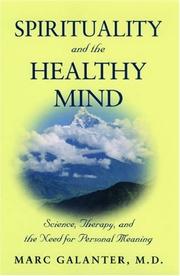
ISBN: 1280844981 0198039247 1429438754 9781429438759 0195176693 9780195176698 9780198039242 9781280844980 9786610844982 6610844984 Year: 2005 Publisher: Oxford ; New York : Oxford University Press,
Abstract | Keywords | Export | Availability | Bookmark
 Loading...
Loading...Choose an application
- Reference Manager
- EndNote
- RefWorks (Direct export to RefWorks)
I. WHAT IS SPIRITUALITY?. 1. Spirituality Emerges. 2. A Psychological Perspective. 3. Spirituality and the Brain. II. THE IMPACT OF CULTURE. 4. The Apparent Conflict. 5. Problems With Spirituality. 6. When Something Is Missing. III. VARIETIES OF SPIRITUAL EXPERIENCE. 7. Christian Psychiatry. 8. Spirituality in India. 9. Liberal Islam. 10. Hospital Chaplaincy: Confronting Illness and Death. IV. SPIRITUAL RECOVERY MOVEMENTS. 11. Alternative Medicine. 12. Alcoholics Anonymous. V. THERAPY OF A DIFFERENT KIND. 13. 14. 15. 16.
Psychotherapy --- Spiritual healing. --- Spirituality. --- Spiritual-mindedness --- Philosophy --- Religion --- Spiritual life --- Divine healing --- Faith-cure --- Faith healing --- Spiritual therapies --- Healing --- Miracles --- Religious aspects. --- Religious aspects --- Spiritual healing --- Spirituality --- 615.851 --- Spiritual Therapies --- Spiritualities --- Psychotherapy. Psychoanalysis as therapy --- methods --- psychology --- methods. --- psychology. --- Spiritual Sensitivity --- Sensitivities, Spiritual --- Sensitivity, Spiritual --- Spiritual Sensitivities
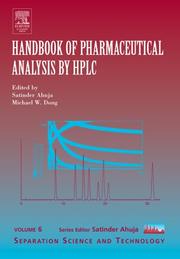
ISBN: 1280630574 9786610630578 0080455182 0120885476 9780080455181 9780120885473 9781280630576 6610630577 Year: 2005 Publisher: Amsterdam ; San Diego : Elsevier Academic Press,
Abstract | Keywords | Export | Availability | Bookmark
 Loading...
Loading...Choose an application
- Reference Manager
- EndNote
- RefWorks (Direct export to RefWorks)
High pressure liquid chromatography-frequently called high performance liquid chromatography (HPLC or, LC) is the premier analytical technique in pharmaceutical analysis and is predominantly used in the pharmaceutical industry. Written by selected experts in their respective fields, the Handbook of Pharmaceutical Analysis by HPLC Volume 6, provides a complete yet concise reference guide for utilizing the versatility of HPLC in drug development and quality control. Highlighting novel approaches in HPLC and the latest developments in hyphenated techniques, the book captures the essence of
High performance liquid chromatography --- Drugs --- Analysis. --- Pharmaceutical analysis --- High performance chromatography --- High pressure liquid chromatography --- High sensitivity liquid chromatography --- High speed liquid chromatography --- HPLC (Chromatography) --- High pressure (Science) --- Liquid chromatography --- Adulteration and analysis
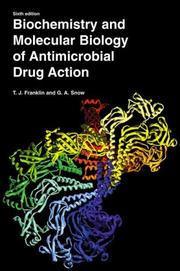
ISBN: 1280656298 9786610656295 0387275665 0387225544 Year: 2005 Publisher: New York, NY : Springer US : Imprint: Springer,
Abstract | Keywords | Export | Availability | Bookmark
 Loading...
Loading...Choose an application
- Reference Manager
- EndNote
- RefWorks (Direct export to RefWorks)
This stimulating new edition of the well-respected title Biochemistry and Molecular Biology of Antimicrobial Drug Action primarily covers medically important antimicrobial agents, but also includes some compounds not in current medical use which have been invaluable as research tools in biochemistry. Since the previous edition, of this book, the impact of molecular biology on our understanding of the mechanisms of antimicrobial action and drug resistance has evolved significantly. This is reflected in the book’s coverage with new material covering the remarkable recent developments in unraveling the complex molecular details of drug interactions with such key targets as ribosomes and the enzymes of nucleic acid replication and microbial cell wall biosynthesis. The new addition also reviews key advances in the biochemistry and molecular biology of drug-resistant pathogens including viruses, parasitic protozoa, fungi and the much feared ‘superbugs’ such as MRSA. Completely updated and rewritten, Biochemistry and Molecular Biology of Antimicrobial Drug Action will be of great use to medical and biological sciences students taking courses in pharmacology, molecular biology, microbiology, biochemistry and chemotherapeutics. Because of the wealth of information within the covers of this important book, all those involved in research into drug action and development, whether in the pharmaceutical industry or academia, will find Biochemistry and Molecular Biology of Antimicrobial Drug Action invaluable. It should also be on the shelves of all libraries, in university medical schools and departments of biological sciences, biochemistry and pharmacology.
Anti-infective agents --- Microbial metabolism. --- Microorganisms --- Physiological effect. --- Effect of antibiotics on. --- Antibiotics --- Microbial sensitivity tests --- Bacterial metabolism --- Metabolism, Bacterial --- Metabolism --- Antiinfective agents --- Antimicrobial agents --- Antimicrobial drugs --- Antimicrobials --- Drugs --- Physiological effect --- Physiology --- Toxicology. --- Biochemistry. --- Microbiology. --- Emerging infectious diseases. --- Pharmacology/Toxicology. --- Biochemistry, general. --- Medical Microbiology. --- Infectious Diseases. --- Emerging infections --- New infectious diseases --- Re-emerging infectious diseases --- Reemerging infectious diseases --- Communicable diseases --- Microbial biology --- Biology --- Biological chemistry --- Chemical composition of organisms --- Organisms --- Physiological chemistry --- Chemistry --- Medical sciences --- Chemicals --- Medicine --- Pharmacology --- Poisoning --- Poisons --- Composition --- Toxicology --- Pharmacology. --- Medical microbiology. --- Infectious diseases. --- Drug effects --- Medical pharmacology --- Chemotherapy --- Pharmacy
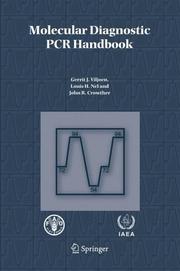
ISBN: 1280283807 9786610283804 1402034040 1402034032 9048168562 9781402034039 Year: 2005 Publisher: Dordrecht : Springer,
Abstract | Keywords | Export | Availability | Bookmark
 Loading...
Loading...Choose an application
- Reference Manager
- EndNote
- RefWorks (Direct export to RefWorks)
PREFACE The Joint FAO/IAEA Division of Nuclear Techniques in Food and Agriculture is involved in agricultural research and development and assists Member States of FAO and IAEA in improving strategies to ensure food security through the use of nuclear techniques and related biotechnologies, where such techniques have a valuable and often unique role. In particular, molecular diagnostic methods have rapidly evolved in the past twenty years, since the advent of the Polymerase Chain Reaction (PCR). They are used in a wide range of agricultural areas such as, improving soil and water management; producing better crop varieties; diagnosing plant and animal diseases; controlling insect pests and improving food quality and safety. The uses of nucleic acid-directed methods have increased significantly in the past five years and have made important contributions to disease control country programmes for improving national and international trade. These developments include the more routine use of PCR as a diagnostic tool in veterinary diagnostic laboratories. However, there are many problems associated with the transfer and particularly, the application of this technology. These include lack of consideration of: the establishment of quality-assured procedures, the required set-up of the laboratory and the proper training of staff. This can lead to a situation where results are not assured. This book gives a comprehensive account of the practical aspects of PCR and strong consideration is given to ensure its optimal use in a laboratory environment. This includes the setting-up of a PCR laboratory; Good Laboratory Practice and standardised of PCR protocols.
Polymerase chain reaction. --- Molecular diagnosis. --- Diagnosis --- Molecular diagnostics --- Molecular biology --- Chain reaction, Polymerase --- PCR (Biochemistry) --- Polymerization --- DNA polymerases --- Molecular aspects --- Medicine. --- Biomedicine general. --- Clinical sciences --- Medical profession --- Human biology --- Life sciences --- Medical sciences --- Pathology --- Physicians --- Health Workforce --- Biomedicine, general. --- Polymerase chain reaction --- Molecular diagnosis --- Polymerase Chain Reaction --- Diagnostic Techniques and Procedures --- 57.082 --- 57.082 Laboratory and museum techniques and equipment for plant and animal specimens and collections --- Laboratory and museum techniques and equipment for plant and animal specimens and collections --- Diagnostic Technics and Procedures --- Technics and Procedures, Diagnostic --- Techniques and Procedures, Diagnostic --- Diagnostic Testing --- Testing, Diagnostic --- Sensitivity and Specificity --- methods
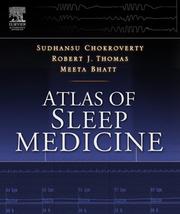
ISBN: 0750673982 9780702038785 0702038784 9780750673983 Year: 2005 Publisher: [Place of publication not identified] Elsevier Butterworth Heinemann
Abstract | Keywords | Export | Availability | Bookmark
 Loading...
Loading...Choose an application
- Reference Manager
- EndNote
- RefWorks (Direct export to RefWorks)
Sleep disorders --- Sleep --- Physiological aspects --- Monitoring, Physiologic --- Diagnostic Techniques and Procedures --- Diagnosis --- Analytical, Diagnostic and Therapeutic Techniques and Equipment --- Polysomnography --- Psychiatry --- Health & Biological Sciences --- Psychiatric Disorders, Individual --- Monitoring, Sleep --- Somnography --- Polysomnographies --- Sleep Monitoring --- Somnographies --- Actigraphy --- Antemortem Diagnosis --- Diagnoses and Examinations --- Examinations and Diagnoses --- Postmortem Diagnosis --- Antemortem Diagnoses --- Diagnoses --- Diagnoses, Antemortem --- Diagnoses, Postmortem --- Diagnosis, Antemortem --- Diagnosis, Postmortem --- Postmortem Diagnoses --- Disease --- Diagnostic Technics and Procedures --- Technics and Procedures, Diagnostic --- Techniques and Procedures, Diagnostic --- Sensitivity and Specificity --- Monitoring, Physiological --- Physiologic Monitoring --- Patient Monitoring --- Monitoring, Patient --- Physiological Monitoring --- Sleeping --- Slumber --- Health --- Psychophysiology --- Rest --- Sleep-wake cycle --- Subconsciousness --- Dreams --- Hypnagogia --- Disorders of sleep --- Nervous system --- Psychology, Pathological --- diagnosis --- methods --- Diseases --- Diagnose --- Diagnostic Testing --- Testing, Diagnostic --- Monitoring, Physiologic. --- Diagnostic Techniques and Procedures. --- Diagnosis. --- Polysomnography.
| Listing 1 - 10 of 27 | << page >> |
Sort by
|

 Search
Search Feedback
Feedback About UniCat
About UniCat  Help
Help News
News